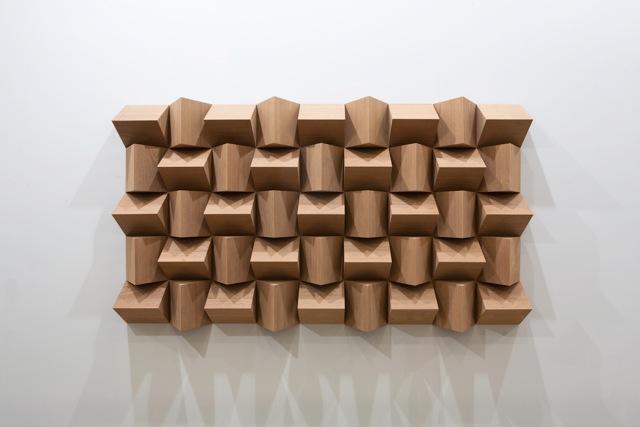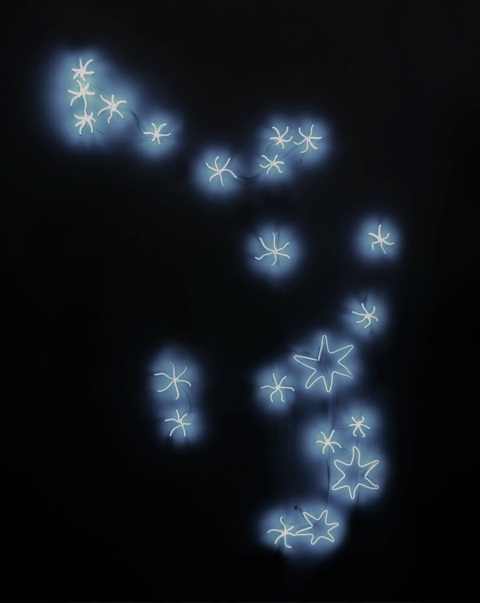藝評
Laurent Grasso
貝卉玲 (Hilary BINKS)
at 2:07pm on 11th May 2012




Captions:
1. Laurent Grasso. Anechoïc wall, 2011. Wood. 35 7/16 x 63 3/4 x 7 1/16 inches (90 x 162 x 18 cm). 45 elements of 7 1/16 inches (18 x 18 x 18 cm). Edition de 4 & 1 A.P. © Laurent Grasso, ADAGP, Paris 2012.
2. Laurent Grasso. 1610 III, 2011. Neon tubes, transformer. 260 x 178 cm (102 3/8 x 70 1/16 inches). edition of 5 & 2A.P. © Laurent Grasso, ADAGP, Paris 2012.
3. Laurent Grasso. Studies into the past. Animal adhesive, resin, boiled oil and pigments on wood panel. 85 x 98 cm painting. 108 x 121 cm framed. © Laurent Grasso, ADAGP, Paris 2012.
4. Laurent Grasso. Psychokinesis, 2008. Video HD & animation. 12 min 30 sec, looped. © Laurent Grasso, ADAGP, Paris 2012.
Images courtesy of Edouard Malingue Gallery.
(原文以英文發表,評論洛朗‧格拉索的作品。)
Everything is possible; not everything can be explained. These are the key tenets of the visionary French artist Laurent Grasso, whose work is exhibited at Edouard Malingue Gallery from April to June 2012 as part of Le French May programme. For the past 10 years, Grasso has created a series of ambitious multimedia projects dedicated to the mysterious and the inexplicable. His works seem to exist somewhere between reality and science fiction, both alarming and seducing the viewer.
Born in 1972, Laurent Grasso lives and works in Paris and New York. He studied at the Ecole Nationale Supérieure des Beaux Arts, Paris; Cooper Union School, New York; and Central Saint Martin’s College of Art and Design, London, with residencies at the Villa Medici, Rome and ISCP, New York. He was awarded the prestigious Marcel Duchamp Prize in 2008.
Grasso’s work encompasses video, sculpture and installations, as well as paintings and drawings. In 2009-2011 he created a temporary glass restaurant, Nomiya, on the roof of the Palais de Tokyo in Paris with unique views of the Eiffel Tower right outside. His projects are inspired by a deep interest in science and what we can and cannot know or perceive. He is fascinated with light, sound, electromagnetic energy, radio waves and naturally occurring scientific phenomena; as well as with the realm of the paranormal.
Grasso’s paintings, neon works and videos are displayed at Edouard Malingue Gallery, while his work Anechoic Pavilion (‘anechoic’ means ‘having a low degree of reverberation of sound’) is installed on the rooftop of Pier 4, Central overlooking Victoria Harbour. It consists of a life-size, one-room cabin, conceived as a peaceful place to retreat to amidst hectic city life and meditate alone. Yet the room is also bisected by a glass wall enabling spectators to observe the person inside. No sooner has the person decided to withdraw from the outside world in order to meditate upon it, than he or she ironically becomes an object of contemplation for the outside world. Privacy is lost and meditation is no longer an intimate, individual experience. Grasso thus creates a minimalist and detached reality which raises questions and alters our perception of the world.
Anechoic Pavilion is typical of the way in which Grasso constantly provokes and challenges the viewer’s senses and perceptions. His video Polair (2007) surveyed buildings in the former East Berlin, such as the iconic television tower, its tramways and various structures that transmit electromagnetic waves. It is unclear whether the white specks floating through the air are natural or alien. Les Oiseaux (2008) depicts a flock of birds against the rosy evening skyline of Rome; taken out of context, they look like an ionic particle field.
Using different media and techniques, Grasso continually unsettles the viewer’s certainties. In Tout est possible (Anything is Possible) (2002) we hear the inner thoughts of a man walking the streets, haunted by ghosts and extraterrestrials. In Radio Ghost (2004) we float above Hong Kong, listening to stories of real-life encounters with ghosts. Projection (2003-2005) depicts a mysterious dense cloud of smoke advancing through the streets of Paris, engulfing cars, buildings and finally the camera itself. In 1619 (2007) the artist created an artificial aurora borealis, while Eclipse (2006) presents a “false miracle” as Grasso uses film technology to stage a beautiful total solar eclipse at sunset. Having studied reports which exposed false UFO sightings and other miraculous events, Grasso wished to play on the line between gullibility and belief. The smoke and the eclipse are fictional but almost plausible. Grasso’s creations lie just beyond the realm of ordinary experience.
On a more sinister theme, for the 2009 Sharjah Biennial, Grasso made Untitled, a video project exploring issues of surveillance and control using footage taken from a camera attached to a falcon in flight. The video The Silent Movie (2010) depicts barely visible military installations along the stunning Cartagena coastline in southern Spain, alternating between the point of view of the attacker and that of the besieged. The stealthy submarine gliding through the water and the ominous hidden guns trained out to sea contrast with the peaceful, sunlit scene and belie the threat of an ever-present enemy.
In The Horn Perspective (2009), Grasso focused on the history of modern physics. In 1964 two American astronomers using the Horn Antenna in New Jersey to study radio emissions from the outer reaches of our galaxy encountered an inexplicable sound. This low-frequency murmur proved to be the “fossil” relic of the Big Bang. Grasso made a sculpture of the antenna, and at the other end of the Centre Pompidou’s Espace 315 he placed a replica of scientist Nikola Tesla’s antenna which was the first to detect radio waves from space. Both structures refer to an unknown world and create a charged atmosphere. The centrepiece of the installation is a video following a path through an idyllic forest setting. Every few seconds, the tranquil scene is disrupted by a swarm of black creatures which descend before dispersing in a trick of digital animation. The crescendo of sound accompanying their swooping evokes the cosmic waves collected by the antennas. In this work, Grasso implies the mystery that the past and present, and different worlds, sometimes coincide.
Grasso explored the theme of time further in Portrait of a Young Man at the Bass Museum of Art (2012), which juxtaposed works from the museum’s permanent collection of Renaissance and Baroque art with Grasso’s own paintings, sculptures, videos and neon works. This allows Grasso to reflect on the Renaissance, the age of discovery when man began seeing the world in a new way. Grasso has produced a series of paintings incorporating imagery reproduced from famous paintings by Fra Angelico, Mantegna and Botticelli, into which he integrates depictions of miraculous phenomena such as eclipses and floating rocks. Once again the artist blurs the line between the historical and the contemporary. Other works include a series of neon signs inspired by Galileo; in 1610 he transforms one of Galileo’s original sketches of a star constellation into neon. Light is an important metaphor for Grasso, as it refers not only to Galileo’s scientific discoveries but to enlightenment in a wider sense.
Through his neon works, videos, installations, paintings and sculptures, Grasso takes the viewer on a magical mystery tour, posing the question, what is real and how far can we accept what we see at face value?
Exhibition: Laurent Grasso: Future Archeology
Date: 26.4. – 16.6.2012
Venue: Edouard Malingue Gallery & Anechoic Pavilion installation venue: Central Ferry Pier 4, Rooftop
|
|
|
|
|
|
